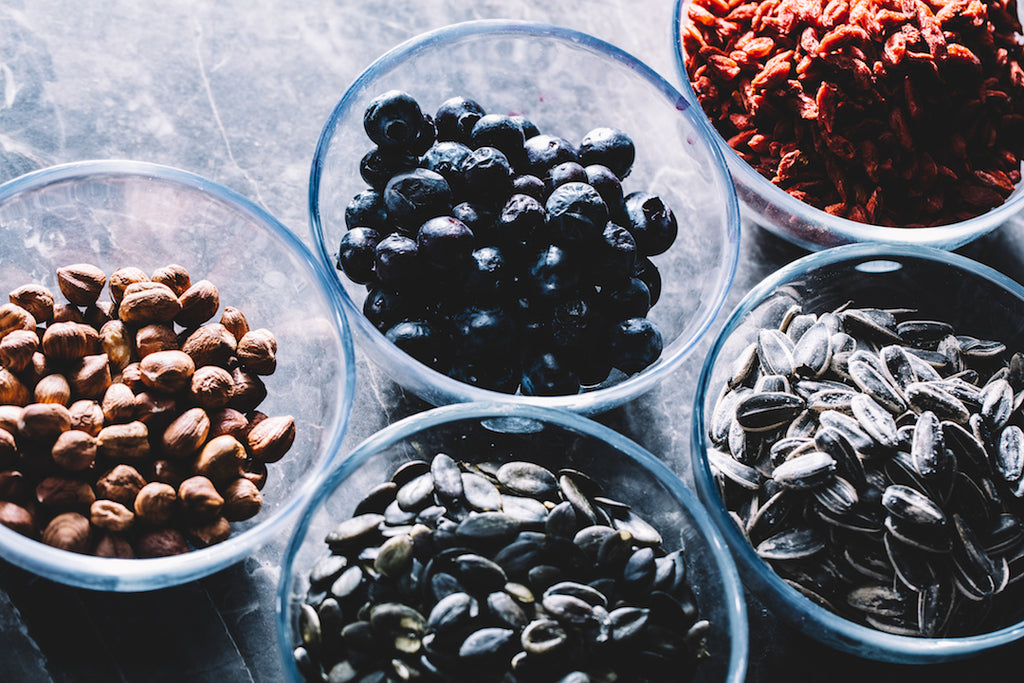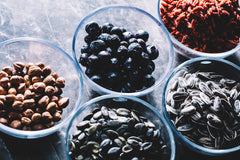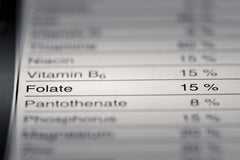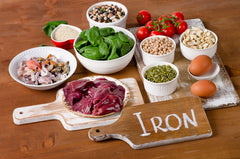Written by Elliot Reimers
Elliot received his B.Sc. in Biology/Biochemistry from the University of Minnesota; he is thoroughly passionate and educated about the science behind human physiology, nutrition, & dietary supplementation. He is a published author on many mainstream fitness/health media sites.
Usage of the term “superfood” has drastically increased in the past decade. Many food and dietary supplement companies tout that their products contain the best superfoods for health and longevity.
Naturally, this begs the question: “What is a superfood?”
Since the term superfood is essentially lingo used for marketing purposes, there is no technical, discrete definition for it. However, that doesn’t mean that there aren’t any true superfoods.
In fact, the phenomenon of health superfoods makes quite a bit of sense in today’s world, where much of our food supply is sapped of micronutrients and loaded with artificial additives.
What Are Superfoods?
Without using any arbitrary prerequisites that qualify a food as being a superfood, it’s safe to broadly define superfoods as foods that are exceptionally rich with micronutrients and often also high in fiber and essential fatty acids. (Remember, this is merely the sense that people use the term superfood for.) When it comes to superfoods, the emphasis seems to be especially on the micronutrient factor.

In contrast to macronutrients, like fat and protein, micronutrients are only necessary in relatively small quantities for health and longevity. Micronutrients are generally broken into subgroups, including vitamins, minerals, and polyphenols.
Even though your body requires a smaller amount of these compounds, they are still undoubtedly essential for your wellness and vitality. In fact, vitamin and mineral deficiencies among the population are considered an alarming health concernby many nutritionists and medical physicians alike.
As alluded to earlier, the cause for this stems from micronutrient-depleted food supply and a general lack of fruit and vegetable intake.
The good news is that superfoods do exist, and they can be highly beneficial. However, many people don’t understand how to actually benefit from these foods. Read on as we detail some of the most prominent superfoods and how you can implement them into your diet for maximum benefit.
The Best Superfoods and How They Can Benefit You
Like the adage goes, “The difference between medicine and poison is in the dose.” It means that pretty much every substance out there has a beneficial dose and a harmful dose.
Ideally, you want to incorporate enough superfoods in your diet to reach a clinically effective intake of their unique health-promoting nutrients, which is exactly what the following subsections will detail.
Turmeric
Turmeric is a perennial plant with a rich golden color and distinct taste, often used in curry dishes. This plant superfood has been used for millennia in traditional Chinese medicine for treating aches/pains, fever, arthritis, autoimmune conditions, and much more.

Turmeric is full of a promising class of heavily studied compounds known as curcuminoids, which are potent antioxidants and immune system enhancers. One particularly important curcuminoid is curcumin, which is abundant in the root of the turmeric plant.
Recent research suggests that curcumin mayreduce the expression of genes that induce muscle-wasting (sarcopenia) pathways in the body. In other words, curcumin appears to be an anti-catabolic compound and can help you maintain lean body mass, especially when nutrient and protein intake is limited.
Furthermore, a recent meta-analysis concludes that curcumin may promote healthy cardiovascular function by modulating blood pressure, as well as alleviate joint pains/aches, reduce inflammation, and support immunity.
It’s important to note that curcumin and other curcuminoids in turmeric have little bioavailability when consumed orally. If you’re taking a turmeric supplement, you’ll want to find one that contains black pepper fruit in it, as this helps increase the absorption of curcumin through your digestive tract.
How Much Turmeric Should You Eat
Pure turmeric powder can be added to many dishes for flavor, but you’ll need to use enough of it to reach a clinically effective dose of curcuminoids (curcumin). Literature demonstrates that at least 500 mg of curcumin per day is necessary for therapeutic benefits.
On average, pure turmeric powder contains roughly 3% curcumin by weight, so 6.8 grams (about one tablespoon) has about 0.204 grams of curcumin, or 204 milligrams. As such, you’ll want to consume at least 3 tablespoons of pure turmeric powder daily to benefit from this superfood. Be sure to combine this superfood with black pepper seasoning as well to maximise the absorption of curcuminoids, or use a curcumin supplement containing black pepper fruit.
Goji Berry
Goji berry, also called the Lycium berry or wolfberry, has more iron than spinach and more vitamin C than oranges (per gram). Goji also contains a high amount of zeaxanthin, an eye-supporting compound similar to lutein that also increases the absorption of essential fatty acids such as EPA and DHA. (If you take an omega-3 fish oil supplement, goji berry is a must-have in your diet.)

Moreover, clinical research shows that goji has potent immune-regulating benefits, particularly in older adults.
How Much Goji Should You Eat
For adults, roughly 180-200 mg of zeaxanthin per day is a clinically effective dose. Depending on where you’re goji berries come from, they may contain anywhere from 80 to 200 mg of zeaxanthin per 100-gram serving, along with over 100% of the recommended daily intake of both vitamin C and iron. Consuming about 100-150 grams of goji berries per day should be plenty for the average adult.
Cocoa
Cocoa is one of nature’s richest plant sources of polyphenols, especially tannins, flavonoids, and stilbenes. A multitude of studies have shown that regular cocoa consumption can benefit your health in several ways, ranging from better carbohydrate metabolism,healthier heart function, and enhanced fatty acid oxidation.

How Much Cocoa Should You Eat
You’ll want to opt for unsweetened cocoa powder as opposed to dark chocolate (which is high in fat and often contains added sugar). An evidence-based dose of pure cocoa powder is roughly 2-3 tablespoons (30-45 grams) per day. The nice thing about cocoa powder is that it can add a nice chocolate flavor to many beverages and recipes; try mixing it in milk or adding it to oatmeal!
Pomegranate
Pomegranate has three time more antioxidants than green tea and red wine, containing rich amounts of vitamin K, vitamin C, polyphenols, and potassium. Research has demonstrated that regularly eating pomegranate may promote healthy blood pressure and cardiovascular function by blocking the actions of angiotensin - a peptide that normally makes your blood vessels constrict (and therefore increase the pressure of your blood against vessels).

How Much Pomegranate Should You Eat
The seeds are the edible portion of the pomegranate innards, with a natural sour and sweet flavor. One whole medium-size pomegranate provides about 200 grams of seeds, which is roughly equivalent to 240 mL of pure pomegranate juice - the amount used daily in the majority of research.
Montmorency Cherry (Tart Cherry)
Montmorency cherry, known commonly as tart cherry, is often sold in the form of a health fruit juice in supermarkets. Tart cherries are loaded with B vitamins, vitamin A, iron, calcium, magnesium, and even omega-3 essential fatty acids.
Research suggests that tart cherries have more than five times the antioxidant capacity than sweet cherry varieties. Other evidence suggests that tart cherry can help reduce blood pressure and ameliorate the symptoms of gout by reducing levels of uric acid in the body.
A simple way to distinguish tart cherries from sweet cherry varieties is by their color; tart cherries have a bright red color, whereas sweet cherries are generally darker - like a maroon hue. Be wary that tart cherry juice you find at the supermarket may contain high amounts of added sugars. Your best bet is to find pure tart cherry juice (without added sugar) or simply whole tart cherries.
How Much Tart Cherry Should You Eat
Most of the health research done on tart cherry consumption had subjects consuming 16 fluid ounces (480 mL) of pure tart cherry juice daily for 6-8 weeks, which is roughly equivalent to 200 tart cherries per day.
Another practical option is to supplement with whole tart cherry powder (not just tart cherry extract, as they aren’t the same), since tart cherry juice can be quite expensive.
Raspberry
Raspberries are one of the most beneficial berries, containing a vast array of potent phytonutrients, such as catechins, ellagic acid, and quercetin, which are shown in clinical research to promote anti-inflammatory actions in the body and support the absorption of essential vitamins and minerals.
Raspberries also contain an exclusive nutrient called raspberry ketone, which gives them their ruby color. Research demonstrates that raspberry ketone has distinct actions in the body and significantly boosts catecholamine-induced lipolysis (fat breakdown).
How Much Raspberry Should You Eat
Per gram, red raspberries have the highest antioxidant capacity of all berries when they are ripe, as well as a high amount of a polyphenols. Ideally, consuming at least 150 grams of red raspberries when they are in the ripe stage will provide the most antioxidant and polyphenol content for health benefits.
Mangosteen
Mangosteen is a white, fleshy fruit known as the “Queen of Fruits” and acclaimed for its refreshing taste and high amounts of manganese and magnesium. Mangosteen also contains a high amount of xanthones, a class of polyphenols that have been shown to promote healthy immune, pancreatic, and cardiovascular functioning.

How Much Mangosteen Should You Eat
Ideally, you should opt for pure mangosteen juice to get the most xanthones, as many of the xanthones in mangosteen come from the rind. Research suggests that about 60 mL of mangosteen juice provides 100 mg of xanthones and can provide health benefits.
Kale
Kale seems to take a back seat to more common cabbage varieties, such as green and red cabbages. Yet, kale contains an incredible number of micronutrients, packing more than 100% of the RDI for vitamins A, C, and K per every 100 grams. Kale also contains a high amount of glucosinolates - a group of compounds that help detoxify the body by inducing key enzymes in your liver.

How Much Kale Should You Eat
Even 100 to 200 grams of kale per day will keep your micronutrient needs covered and provide your body with a substantial amount of detoxifying glucosinolates (which are otherwise lacking in most diets). If you’re looking for an added cleansing boost, supplementing with detoxifying herbs like dandelion and DGL licorice make for a great adjunct to kale.
Acai
The acai berry may be rather tiny in physical size, but don’t let that deter you from its astonishing number of anthocyanins, such as resveratrol. Anthocyanins are a type of flavonoid phytopigment found in most berries that have been shown to promote healthy blood lipid levels, as well as enhance digestion, weight loss, energy levels immune function, and longevity.
How Much Acai Should You Eat
Consuming acai freeze-dried pulp powder or concentrated acai juice is the best way to get a high number of anthocyanins without all the sugar from whole acai berries. Either way, eating 100 grams of acai berries per day will provide nearly 30 times the anthocyanin content of a 6 oz glass of red wine.
Key Takeaways
Micronutrients are just as essential to your health and longevity as macronutrients. If your diet contains mostly micronutrient-devoid, highly processed foods, your risk of health complications will likely increase (significantly).
Does this mean you should eat only the superfoods mentioned in this article? Certainly not, but even four or five servings daily of any of these superfoods will benefit you in more ways than one. Be sure to watch your sugar and calorie intake if you’re consuming several servings of fruit superfoods. In some circumstances, using a supplemental version of fruit superfoods - like Montmorency cherry powder - is the more prudent option, especially if you’re trying to keep sugar/calorie intake down.






